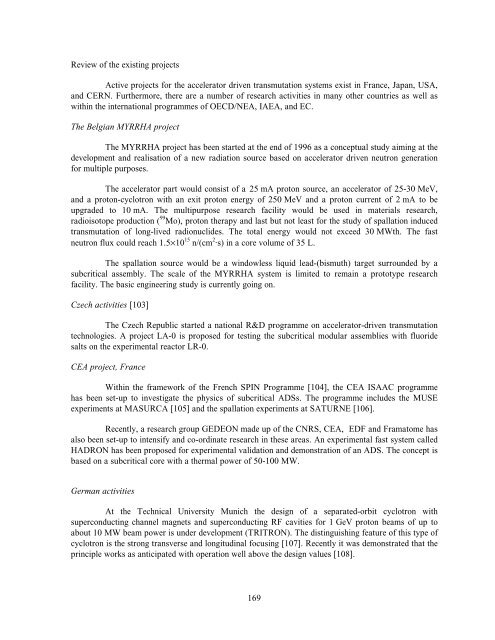COMPLETE DOCUMENT (1862 kb) - OECD Nuclear Energy Agency
COMPLETE DOCUMENT (1862 kb) - OECD Nuclear Energy Agency
COMPLETE DOCUMENT (1862 kb) - OECD Nuclear Energy Agency
Create successful ePaper yourself
Turn your PDF publications into a flip-book with our unique Google optimized e-Paper software.
Review of the existing projects<br />
Active projects for the accelerator driven transmutation systems exist in France, Japan, USA,<br />
and CERN. Furthermore, there are a number of research activities in many other countries as well as<br />
within the international programmes of <strong>OECD</strong>/NEA, IAEA, and EC.<br />
The Belgian MYRRHA project<br />
The MYRRHA project has been started at the end of 1996 as a conceptual study aiming at the<br />
development and realisation of a new radiation source based on accelerator driven neutron generation<br />
for multiple purposes.<br />
The accelerator part would consist of a 25 mA proton source, an accelerator of 25-30 MeV,<br />
and a proton-cyclotron with an exit proton energy of 250 MeV and a proton current of 2 mA to be<br />
upgraded to 10 mA. The multipurpose research facility would be used in materials research,<br />
radioisotope production ( 99 Mo), proton therapy and last but not least for the study of spallation induced<br />
transmutation of long-lived radionuclides. The total energy would not exceed 30 MWth. The fast<br />
neutron flux could reach 1.5×10 15 n/(cm 2·s) in a core volume of 35 L.<br />
The spallation source would be a windowless liquid lead-(bismuth) target surrounded by a<br />
subcritical assembly. The scale of the MYRRHA system is limited to remain a prototype research<br />
facility. The basic engineering study is currently going on.<br />
Czech activities [103]<br />
The Czech Republic started a national R&D programme on accelerator-driven transmutation<br />
technologies. A project LA-0 is proposed for testing the subcritical modular assemblies with fluoride<br />
salts on the experimental reactor LR-0.<br />
CEA project, France<br />
Within the framework of the French SPIN Programme [104], the CEA ISAAC programme<br />
has been set-up to investigate the physics of subcritical ADSs. The programme includes the MUSE<br />
experiments at MASURCA [105] and the spallation experiments at SATURNE [106].<br />
Recently, a research group GEDEON made up of the CNRS, CEA, EDF and Framatome has<br />
also been set-up to intensify and co-ordinate research in these areas. An experimental fast system called<br />
HADRON has been proposed for experimental validation and demonstration of an ADS. The concept is<br />
based on a subcritical core with a thermal power of 50-100 MW.<br />
German activities<br />
At the Technical University Munich the design of a separated-orbit cyclotron with<br />
superconducting channel magnets and superconducting RF cavities for 1 GeV proton beams of up to<br />
about 10 MW beam power is under development (TRITRON). The distinguishing feature of this type of<br />
cyclotron is the strong transverse and longitudinal focusing [107]. Recently it was demonstrated that the<br />
principle works as anticipated with operation well above the design values [108].<br />
169
















